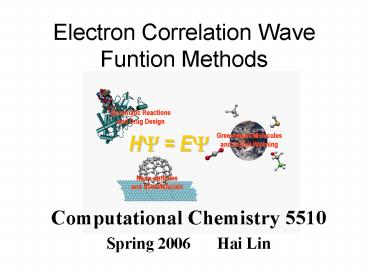Electron Correlation Wave Funtion Methods - PowerPoint PPT Presentation
1 / 16
Title:
Electron Correlation Wave Funtion Methods
Description:
For : Fermi hole. Electron correlation energy. Ecorr = Eexact - EHF. HF calculations do not account for electron correlation. ... We only discuss RHF (and ROHF) ... – PowerPoint PPT presentation
Number of Views:89
Avg rating:3.0/5.0
Title: Electron Correlation Wave Funtion Methods
1
Electron Correlation Wave Funtion Methods
Computational Chemistry 5510 Spring 2006 Hai Lin
2
Electron Correlation Energy
- Electrons avoid each other
Probability of finding another electron
Intra-orbital correlation
r(x)
Inter-orbital correlation
x
For Coulomb hole For Fermi hole
- Electron correlation energy
Ecorr Eexact - EHF
- HF calculations do not account for electron
correlation. - We only discuss RHF (and ROHF) if not otherwise
indicated.
3
Excited Slater Determinants
- Replace occupied MO by unoccupied MO in the
determinant in the HF calculation.
fj(x1)
fk(x1)
fi(x1)
fj(x2)
fk(x2)
fi(x2)
F(x1, x2, , xN ) (1/N!)½
fj(xN)
fk(xN)
fi(xN)
4
Multi-determinant Trial Wave Function
- More determinants, a better many-electron wave
function
Complete CI expansion Exact solution to
electronic Schrödinger equation
Full CI expansion Best many-electron WF
Number of determinants
Complete basis set limit Best one-electron MO
HF
Basis set size
Minimum Basis set
5
How Many Determinants?
- Number of determinants goes dramatically.
- H2O with 6-31G(d) basis 10 electrons in 38
orbitals - Total of determinants 38! / 10!(38-10)!
- Total of singlet (S ½) determinants 3?107
- H2O with 6-311G(2d,2p) basis 10 electrons in 82
orbitals - Total of determinants 82! / 10!(82-10)!
- Total of singlet (S ½) determinants 1?1011
- C2H4 with 6-31G(d) basis 16 electrons in 76
orbitals - Total of determinants 76! / 16!(76-16)!
- Total of singlet (S ½) determinants 3?1014
E 0
- Frozen core and frozen virtuals approximations
O 1s2 2s2 2p4 3s0 3p0 3d0 4s0 4p0
6
Electron Correlation Methods
- How many and which determinants to be included?
- How to construct those determinants?
- How to determine the expansion coefficients ai?
- Configuration interaction (CI)
- Multi-configuration self-consistent field (MCSCF)
- Many-body Moller-Plesset perturbation theory
(MPn) - Coupled cluster (CC)
7
Configuration Interaction
- Determine the expansion coefficients ai
variationally. - Full-CI is feasible only for small system with
small basis sets. - Truncated CI at singly and doubly excitations
(CISD) is the most popular CI method.
8
MCSCF
- Variationally not only optimize the expansion
coefficients ai, but also optimize the MOs (F)
themselves like HF does. That is, optimize the
coefficients both between and within F. - Which MOs to be included in the expansion
requires your chemical insights.
E 0
- Complete active space self-consistent field
(CASSCF) performs MCSCF calculations with a
full-CI expansion for a selected active space. - n,m-CASSCF n electrons in m orbitals of the
active space
Full-CI expansion for the active space
9
MCSCF vs. HF
- Both HF and MCSCF optimize MOs.
- HF uses single determinant, while MCSCF uses many
determinants. - Advanced electron correlation methods
constructing wave function based on - HF optimized MOs single-reference methods,
e.g., CI. - MCSCF optimized MOs multi-reference methods,
e.g., MR-CI. - When single-determinant HF fails to provide a
qualitatively correct zero-order description, you
should try MCSCF.
O
O
?O
O
O?
O-
10
Perturbation Theory
- Devide the exact Hamiltonian H into two parts An
unperturbed reference H0 and a pertubation H'.
H H0 H'
For the reference Hamiltonian operator H0, the
solution is known.
H0 Fi0 Ei0 Fi0, (i 0, 1, 2, ...)
For the exact Hamiltonian operator H, the
solution can be obtained
H Yi ei Yi
Yi Fi0 Fi1 Fi2 ...
Corrections
ei Ei0 Ei1 Ei2 ...
The corrections can be expressed in terms of H',
Fi0 and Ei0.
11
MPn
- Devide the exact electronic Schrödinger
Hamiltonian H into two parts
H H0 H'
Sum of the Fock operators SFi
All the remaining terms ? Fluctuation potential
Corrections to the n-th order are known as MPn
H Yi ei Yi
Yi Fi0 Fi1 Fi2 ...
Corrections
ei Ei0 Ei1 Ei2 ...
- Not a variational method ? the energy can be
lower than the exact energy. - Not necessarily converge with increasing n.
12
Coupled Cluster Methods
- Most advanced methods
- Rather reliable if work with large basis sets
(e.g., cc-pVQZ) - Commonly used CCSD, CCSD(T)
- Often used as reference calculations to assess
and/or calibrate other less-expensive methods
(e.g., DFT)
13
Size Consistency
- 2EA ? EB
CIS two excitations
CIS one excitation
100 Å
? 2
- Truncated CI methods (e.g., CIS) are not size
consistent. - Full-CI is size consistent.
- HF, DFT, MPn, and CC methods are size consistent.
14
Which Method to Use?
- When single-determinant HF fails to provide a
qualitatively correct zero-order wavefunction,
you should try MCSCF. - Truncated CI is not size consistent, and is
usually not recommended if other methods are
feasible. - Excited states are difficult to treated by MPn
and CC methods, and MCSCF and CI (especially
MR-CI) are the choice. - CCSD(T) with sizeable basis sets may reach
chemical accuracy ( 1kcal/mol).
MP2
CISD, CCSD
MP4
CCSD(T)
HF
Accuracy computational cost
15
Summary
- Electron Correlation
- Excited Slater determinants
- Multi-determinant trial wave function
- Electron Correlation Methods
- CI
- MCSCF
- MPn
- CC
- Size-consistency
16
Your Homework
- Read the slides.
- Read textbook (Take notes when you read.)
- 4 pages 98 102, 117 122, 144 146
- Skip the discussion on UHF, natrual orbital, and
localized orbitals methods. - Questions
- What is a S-type excited Slater determinant?
D-type? - What is a frozen core approximation?
- What is the major difference between CI and
MCSCF? - What is a single-reference method and what is a
multi-reference method?































